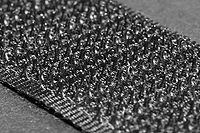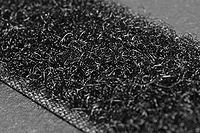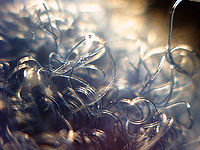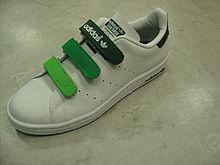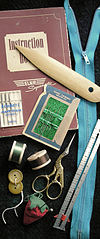- Velcro
-
Velcro is the brand name of the first commercially marketed fabric hook-and-loop fastener,[1] invented in 1948 by the Swiss electrical engineer George de Mestral. De Mestral patented Velcro in 1955, subsequently refining and developing its practical manufacture until its commercial introduction in the late 1950s.
The word Velcro is a portmanteau of the two French words velours ("velvet"), and crochet ("hook").[1][2][3]
Hook-and-loop fasteners consist of two components: typically, two lineal fabric strips (or, alternatively, round "dots" or squares) which are attached (e.g., sewn, adhered, etc.) to the opposing surfaces to be fastened. The first component features tiny hooks; the second features even smaller and "hairier" loops. When the two faces are pressed together, the hooks catch in the loops and the two pieces fasten or bind temporarily.[4] When separated, by pulling or peeling the two surfaces apart, the velcro strips make a distinctive "ripping" sound.
The first Velcro sample was made of cotton, which proved impractical[5] and was replaced by Nylon and polyester.[6] Velcro fasteners made of Teflon loops, polyester hooks, and glass backing are used in aerospace applications, e.g. on space shuttles.[6]
Variations on the standard Velcro hook and loop fasteners include hooks on both faces, buttons, zippers, laces, and buckles.
George de Mestral's patent expired in 1978, but the term Velcro is a registered trademark in most countries. Generic terminology for these fasteners includes "hook and loop", "burr" and "touch" fasteners. However the Velcro brand is an example of a genericized trademark as its brand name has become the generic term in many languages. The Velcro company headquarters is in Manchester, New Hampshire, USA.
Contents
History
 Tiny hooks can be seen covering the surface of this burr. The design of Velcro imitated this natural mechanism for seed dispersion.
Tiny hooks can be seen covering the surface of this burr. The design of Velcro imitated this natural mechanism for seed dispersion.
The hook-and-loop fastener was invented in 1941 by Swiss engineer, Georges de Mestral[2][7][8] who lived in Commugny, Switzerland. The idea came to him one day after returning from a hunting trip with his dog in the Alps. He took a close look at the burrs (seeds) of burdock that kept sticking to his clothes and his dog's fur. He examined them under a microscope, and noted their hundreds of "hooks" that caught on anything with a loop, such as clothing, animal fur, or hair.[5] He saw the possibility of binding two materials reversibly in a simple fashion,[8] if he could figure out how to duplicate the hooks and loops.[2]. This inspiration from nature or the copying of nature's mechanisms (called bionics or biomimesis) is viewed by some like Steven Vogel[9] or Werner Nachtigall[10] as a key example.
Originally people refused to take him, and the idea, seriously when he took his idea to Lyon, which was then a center of weaving. He did manage to gain the help of one weaver, who made two cotton strips that worked. However the cotton wore out quickly, so de Mestral turned to synthetic fibers.[5] He settled on nylon as being the best synthetic, which had several advantages. Nylon doesn’t break down, rot, or attract mold, and it could be produced in threads of various thickness.[6] Nylon had only recently been invented, and through trial and error he eventually discovered that, when sewn under hot infrared light, nylon forms hooks that were perfect for the hook side of the fastener.[2] Though he had figured out how to make the hooks, he had yet to figure out a way to mechanize the process, and to make the looped side. Next he found that nylon thread, when woven in loops and heat-treated, retains its shape and is resilient; however, the loops had to be cut in just the right spot so that they could be fastened and unfastened many times. On the verge of giving up, a new idea came to him. He bought a pair of shears and trimmed the tops off the loops, thus creating hooks that would match up perfectly with the loops in the pile.[5]
Mechanizing the process of weaving the hooks took eight years, and it took another year to create the loom that trimmed the loops after weaving them. In all, it took ten years to create a mechanized process that worked.[5] He submitted his idea for patent in Switzerland in 1951 and the patent was granted in 1955.[2] Within a few years he obtained patents and began to open shops in Germany, Switzerland, Great Britain, Sweden, Italy, the Netherlands, Belgium, and Canada. In 1957 he branched out to the textile center of Manchester, New Hampshire in the United States. Columnist Sylvia Porter made the first mention of the product in her column Your Money's Worth of August 25, 1958, writing "It is with understandable enthusiasm that I give you today an exclusive report on this news: A 'zipperless zipper' has been invented — finally. The new fastening device is in many ways potentially more revolutionary than was the zipper a quarter century ago."[11] A Montreal firm, Velek, Ltd., acquired the exclusive right to market the product in North and South America, as well as in Japan, with American Velcro, Inc. of New Hampshire, and Velcro Sales of New York, marketing the "zipperless zipper" in the United States.[12]
De Mestral obtained patents in many countries right after inventing Velcro as he expected a high demand immediately. Partly due to its appearance, though, Velcro's integration into the textile industry took time.[citation needed] At the time, Velcro looked like it had been made from leftover bits of cheap fabric, and thus was not sewn into clothing or used widely when it debuted in the early 1960s.[13] It was also viewed as impractical.[13]
 De Mestral saw Velcro as a replacement for zippers, among other things.
De Mestral saw Velcro as a replacement for zippers, among other things.
Velcro got its first break when it was used in the aerospace industry to help astronauts maneuver in and out of bulky space suits. However, this reinforced the view among the populace that Velcro was something with very limited utilitarian uses. The next major use Velcro saw was with skiers, who saw the similarities between their costume and the astronauts, and thus saw the advantages of a suit that was easier to don and remove. Scuba and marine gear followed soon after. After seeing astronauts storing food pouches on walls[14], children's clothing makers came onboard.[13] As Velcro only became widely used after NASA's adoption of it, NASA is popularly — and improperly — credited with its invention.
Later improvements included strengthening the filament by adding polyester.[6]
In 1978 de Mestral's patent expired, prompting a flood of low-cost imitations from Taiwan, China and South Korea onto the market. Today, the trademark is the subject of more than 300 trademark registrations in over 159 countries.[specify] George de Mestral was inducted into the national inventors hall of fame for his invention.[5] He once offered some advice to Velcro executives:
"If any of your employees ask for a two-week holiday to go hunting, say yes."
The big breakthrough George de Mestral made was to think about hook-and-eye closures on a greatly reduced scale. Hook and eye fasteners have been common for centuries, but what was new about Velcro was the scale of the hooks and eyes. Shrinking the hooks led to the two other important differences. Firstly, instead of a single-file line of hooks, Velcro has a two-dimensional surface.[15] This was needed, because in decreasing the size of the hooks, the strength was also unavoidably lessened, thus requiring more hooks for the same strength. The other difference is that Velcro has indeterminate match-up between the hooks and eyes. With larger hook and eye fasteners, each hook has its own eye. On a scale as small as that of Velcro, matching up each of these hooks with the corresponding eye is impractical, thus leading to the indeterminate matching.[15]
Genericized trademark
The Velcro brand is an example of a genericized trademark — a brand name that has become the generic term for a type of product. The Velcro company has forbidden its employees to use the term "Velcro",[13] in an effort to stop this. Instead the employees must use the generic terms "hook and loop fastener", "hook tape", or "loop tape". The company is very protective, and refer to their product as "the Velcro brand hook-and-loop fastener". The company publishes detailed trademark guidelines designed to preserve the strength of the Velcro brand.[16]
Besides being used as a generic term for hook and loop fasteners, the word "Velcro" has also become a verb, as in "Velcroed", which means to be attached by Velcro. It has been used as such since approximately 1972.[citation needed]
Strength
Velcro is strong enough that a two inch square piece is enough to support a 175 pounds (79 kg) person.[13] The strength of the bond depends on how well the hooks are embedded in the loops, how much surface area is in contact with the hooks, and the nature of the force pulling it apart. If Velcro is used to bond two rigid surfaces, e.g. auto body panels and frame, the bond is particularly strong because any force pulling the pieces apart is spread evenly across all hooks. Also, any force pushing the pieces together is disproportionally applied to engaging more hooks and loops. Vibration can cause rigid pieces to improve their bond. Full-body Velcro suits have been made that can hold a person to a suitably covered wall.
When one or both of the pieces is flexible, e.g. a pocket flap, the pieces can be pulled apart with a peeling action that applies the force to relatively few hooks at a time. If a flexible piece is pulled in a direction parallel to the plane of the Velcro surface, then the force is spread evenly as it is with rigid pieces.
Three ways to maximize the strength of a bond between the two flexible pieces are:
- increase the area of the bond, e.g. using larger pieces of Velcro
- ensure that the force is applied parallel to the plane of the fastener surface, e.g. bending around a corner or pulley.
- increase the number of hooks and loops per area unit.
Shoe closures can resist a large force with only a small amount of Velcro. This is because the strap is wrapped through a slot, halving the force on the bond by acting as a pulley system (thus gaining a mechanical advantage), and further absorbing some of the force in friction around the tight bend. This layout also ensures that the force is parallel to the Velcro strips.
Advantages and disadvantages
In favor of Velcro, it is easy to use, safe, and maintenance free. There is only a minimal decline in effectiveness even after many fastening and unfastenings. The tearing noise it makes can also be useful against pickpockets. Additionally, in the United States Air Force, where Velcro is used to attach patches to flight suits, aircrew have learned that they can remove small cloth pile balls that accumulate on the suits by using the hook side on the back of the patches like a brush to remove them.
Velcro has several deficiencies: it tends to accumulate hair, dust, and fur in its hooks after a few months of regular use. The loops can become elongated or broken after extended use. Velcro often becomes attached to articles of clothing, especially loosely woven items like sweaters. Additionally, the clothing may be damaged when one attempts to remove the Velcro, even if they are separated slowly. The tearing noise made by unfastening Velcro makes it inappropriate for some applications. For example, a soldier hiding from the enemy would not want to alert the enemy to his or her position by opening a Velcro pocket.[2] It also absorbs moisture and perspiration when worn next to the skin, which means it will smell if not washed.
Textiles can contain chemicals or compounds, e.g. dyes,[17] that may be allergenic to sensitive populations. Velcro products have been tested according to the Oeko-tex certification standard which imposes limits on the chemical content of textiles to address the issue of human ecological safety.
Applications
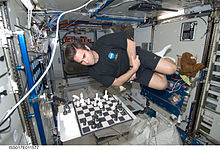 NASA astronaut Greg Chamitoff ponders his next move with a Velcro-modified chess set on board the ISS. Also visible up and to the left are bare Velcro pads for affixing
NASA astronaut Greg Chamitoff ponders his next move with a Velcro-modified chess set on board the ISS. Also visible up and to the left are bare Velcro pads for affixing
Because it is easy to use, maintenance free and safe, the hook-and-loop fasteners have been used for just about every conceivable application where a temporary bond is required. It is especially popular in clothing where it replaces buttons or zippers, and as a shoe fastener for children who have not yet learned to tie shoelaces and for those who choose Velcro over laces. Velcro is used in adaptive clothing, which is clothing designed for people with physical disabilities, the elderly, and the infirm who may experience difficulty dressing themselves due to an inability to manipulate closures, such as buttons and zippers. As Velcro is easier to manipulate, it makes a good replacement.
Velcro held together a human heart during the first artificial heart surgery, and it is used in nuclear power plants and army tanks to hold flashlights to walls. Cars use it to bond headliners, floor mats and speaker covers. It is used in the home when pleating draperies, holding carpets in place and attaching upholstery, among many other things.[5] It closes backpacks, briefcases and notebooks, secures pockets, and holds disposable diapers, and diaper covers for cloth diapers, on babies. It is an integral part of the game tag rugby, is used in surfboard leashes and orthopaedic braces.
NASA makes significant use of Velcro. Each space shuttle has ten thousand inches of a special Velcro made of Teflon loops, polyester hooks, and glass backing.[6] Velcro is used everywhere, from the astronauts' suits, to anchoring equipment. In the near weightless conditions in orbit, Velcro is used to temporarily hold objects and keep them from floating away.[18] A Velcro patch is used inside astronauts' helmets where it serves as a nose scratcher.[5][6] During mealtimes astronauts use trays that attach to their thighs using spring and Velcro fasteners.[14]
The US Army is another big user. It uses Velcro fasteners on combat uniforms to attach name tapes, rank insignia, shoulder pockets for unit patches, skill tabs, and recognition devices, such as the infrared (IR) feedback American flag. They also had a silent version of Velcro developed for use with Army soldier uniforms, as the ripping sound could betray a soldier's position. A new version was created which reduced the noise by over 95%. The manufacturing process to create this noiseless Velcro is, however, a military secret.[6]
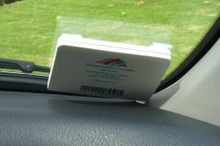 RFID attached with Velcro
RFID attached with Velcro
There have been some failed uses for Velcro as well. One such failure was a worm collar that consisted of a cylindrical strip that fishers were supposed to slip over their live bait. The Velcro was supposed to snag in the teeth of striking bass. Another failure was a strap-on device for impotent men.[6]
Velcro jumping
Velcro jumping is a game where people wearing Velcro-covered suits take a running jump and hurl themselves as high as possible at a Velcro-covered wall.[6][19] The wall is inflated, and looks similar to other inflatable structures. It is not necessarily completely covered in Velcro—often there will be vertical strips of Velcro. Sometimes, instead of a running jump, people use a small trampoline.
Television show host David Letterman immortalized this during the February 28, 1984 episode of Late Night with David Letterman on NBC. Letterman proved that with enough Velcro a man could be hurled against a wall and stick, by performing this feat during the television broadcast.[5][13][19] This put Velcro in the national spotlight.[13][dubious ]
Velcro jumping goes beyond David Letterman, though. Amusement companies rent Velcro walls and jumpsuits for $400-$500 a day.[19] It was also done on a regular basis in pubs in both New York and New Zealand, where it is a competition to see how high a person can get their feet above the ground.[20] Jeremy Bayliss and Graeme Smith of the Cri Bar and Grill in Napier, New Zealand, started it after seeing American astronauts Velcroed to walls during space flights. They created their own equipment for the "human fly" contests, and sold it to several others in New Zealand.[20]
The game moved to the U.S. after Sports Illustrated published a story on it in 1991. Adam Powers and Stephen Wastell of the Perfect Tommy's bar in New York city read of the game, and soon became the United States distributor of Human Bar Fly equipment. Velcro wall-jumping now exists in dozens of New Zealand bars and is said to be one of the favorite bar activities there.[20]
Variations on Velcro
Leonard Duffy, noting the disadvantages of Velcro, and taking Velcro as his model, created a new product called the "slidingly engaging fastener". Instead of loops and hooks, it has interlocking islands with undercut edges that slide together.[21][22] Duffy then created a wraparound cast made from a single plastic sheet sealed with his fasteners to replace similar removable casts with Velcro straps. His sister-in-law had a removable cast with Velcro strips, and complained about the Velcro because it absorbed perspiration and thus smelled, as well as catching on her clothing.[21][22] With the Unity Wrap, Duffy won the grand prize in NASA's "Create the Future" invention contest. Since then the sliding engaging fastener has become available at Material ConneXion, a global materials consultancy and library of innovative and sustainable materials, and several designers and a prosthetics company have expressed interest.[21][22]
The advantages of this new Velcro are that it is more durable (it does not wear down over time), is eight times stronger, and makes no noise when fastened or unfastened.[21][22] However it is thicker and bulkier, which limits some of its applications. It also is not as flexible as Velcro.
Heavy duty variants (e.g., "Dual Lock" by 3M) feature mushroom shaped stems on each face of the velcro, providing an audible snap when the two faces mate. A strong adhesive backing adheres each component to its substrate.
Velcro in popular culture
Velcro has worked its way into popular culture and common knowledge. As such, it has been part of many movies, and mentioned in songs and television shows. The early 90s sitcom Parker Lewis Can't Lose featured a character–Jerry Steiner–with a seemingly bottomless jacket filled with tools and supplies, all of which were removed with the familiar Velcro tearing sound. In the 1996 John Frankenheimer film The Island of Dr. Moreau, Moreau's assistant jokingly claims that the doctor won his Nobel Prize for inventing Velcro.[23]
Velcro has become part of a recurring joke in various media in which it is claimed that modern humans would be unable to invent it, and that it is in fact a form of advanced technology. For example, K claims in Men in Black that Velcro was originally alien technology,[24] and a 2002 Star Trek Enterprise episode features Velcro as being given to modern society by Vulcans in 1957. As a tongue in cheek reference, one of the Vulcans in the episode was named Mestral, after Velcro's actual inventor.[25] More recently one of the characters in the 2004 film Garden State made a vast fortune from inventing silent Velcro.[26] Sacha Baron Cohen's character Bruno wears a "Velcro" suit in the movie of the same name (which causes him to have everything made of cloth to attach to himself, consequently leading to disastrous results and ultimately causes the loss of his job).
That Velcro has entered popular culture is also evidenced by its use as a verb, as in "He velcroed his shoes." meaning to fasten the shoes with Velcro.[1]
It is also the subject of a classic joke by the legendary punslinger Tim Vine who said: "Velcro. What a rip off!"
See also
References
- ^ a b c "Velcro." The Oxford English Dictionary. 2nd ed. 1989.
- ^ a b c d e f Stephens, Thomas (2007-01-04). "How a Swiss invention hooked the world". swissinfo.ch. http://www.swissinfo.ch/eng/search/Result.html?siteSect=882&ty=st&sid=7402384. Retrieved 2008-05-09.
- ^ "Who is Velcro USA Inc.?". Velcro. http://www.velcro.com/index.php?page=who-is-velcro-r. Retrieved 2009-09-07.
- ^ "Velcro". Merriam Webster. http://www.merriam-webster.com/dictionary/velcro. Retrieved 2008-05-10.
- ^ a b c d e f g h i Strauss, Steven D. (December 2001). The Big Idea: How Business Innovators Get Great Ideas to Market. Kaplan Business. pp. 15-pp.18. ISBN 0793148375. http://books.google.com/books?id=F_yOHB54CxsC&pg=PA18. Retrieved 2008-05-09.
- ^ a b c d e f g h i Schwarcz, Joseph A. (October 2003). Dr. Joe & What You Didn't Know: 99 Fascinating Questions About the Chemistry of Everyday Life. Ecw Press. pp. 178. ISBN 1550225774. http://books.google.com/books?id=vAXcX2xm6esC&pg=PA178. Retrieved 2008-05-09. "But not every Velcro application has worked ... A strap-on device for impotent men also flopped."
- ^ McSweeney, Thomas J.; Stephanie Raha (August 1999). Better to Light One Candle: The Christophers' Three Minutes a Day: Millennial Edition. Continuum International Publishing Group. pp. 55. ISBN 0826411622. http://books.google.com/books?id=-1Vm4OZ1B44C&pg=PA57. Retrieved 2008-05-09.
- ^ a b "About Us:History". Velcro.uk. http://www.velcro.co.uk/cms/History.6.0.html?&L=96581. Retrieved 2008-05-09.
- ^ Vogel, S. 1988. Life's devices: the physical world of animals and plants. Princeton paperbacks. ISBN 0691024189, 9780691024189
- ^ Nachtigall, W. 1974. Biological Mechanisms of Attachment:the comparative morphology and bionengineering of organs for linkage New York : Springer-Verlag
- ^ Sylvia Porter, "Your Money's Worth", Syracuse Herald-Journal, August 25, 1957, p21
- ^ Id.
- ^ a b c d e f g Freeman, Allyn; Bob Golden (September 1997). Why Didn't I Think of That: Bizarre Origins of Ingenious Inventions We Couldn't Live Without. Wiley. pp. 99-pp.104. ISBN 0471165115. http://books.google.com/books?id=EVafPNDvWlYC&pg=PA99. Retrieved 2008-05-09.
- ^ a b Jones, Thomas; Michael Benson (January 2002). The Complete Idiot's Guide to NASA. Alpha. pp. 130–132. ISBN 0028642821. http://books.google.com/books?id=GKvAsaUOA-QC&pg=PA18&dq=velcro+George+de+Mestral&lr=&client=opera&sig=Lhg3mfzQagC1lwrI5BeRVT0gC2A. Retrieved 2008-05-09.
- ^ a b Weber, Robert John (February 1993). Forks, Phonographs, and Hot Air Balloons: A Field Guide to Inventive Thinking. Oxford University Press. pp. 157–160. ISBN 019506402X. http://books.google.com/books?id=ot_he70nIokC&pg=PA158. Retrieved 2008-05-09.
- ^ "Proper Use of Trademarks". Velcro. http://www.velcro.com/index.php?page=patents-trademarks. Retrieved 2010-02-04.
- ^ Crespo et al, Contact Dermatitis, 2009
- ^ Jones, Thomas; Michael Benson (January 2002). The Complete Idiot's Guide to NASA. Alpha. pp. 18. ISBN 0028642821. http://books.google.com/books?id=GKvAsaUOA-QC&pg=PA18&dq=velcro+George+de+Mestral&lr=&client=opera&sig=Lhg3mfzQagC1lwrI5BeRVT0gC2A. Retrieved 2008-05-09.
- ^ a b c Sennett, Frank (November 2004). 101 Stunts for Principals to Inspire Student Achievement. Corwin Press. pp. 86. ISBN 076198836X. http://books.google.com/books?id=vnLetsZ4l4kC&pg=PA85. Retrieved 2008-05-09.
- ^ a b c Kleinfield, N. R. (1992-01-05). "Fly Through Air, Hit a Wall. Now Stay There.". New York Times. http://query.nytimes.com/gst/fullpage.html?res=9E0CE2DA1231F936A25752C0A964958260&sec=&spon=&pagewanted=all. Retrieved 2008-05-12.
- ^ a b c d Mone, Gregory (2007-05-14). "Invention awards The New Velcro". Popular Science. http://www.popsci.com/node/9642. Retrieved 2008-05-10.
- ^ a b c d Body Beauty (2007-06-11). "Velcro Reinvented". InventorSpot.com. http://inventorspot.com/reinvented_velcro. Retrieved 2008-05-10.
- ^ Maslin, Janet (1996-08-23). "The Island of Dr. Moreau (1996)". The New York Times. http://movies.nytimes.com/movie/review?res=9F06E0D91130F930A1575BC0A960958260. Retrieved 2008-05-11.
- ^ Tatara, Paul (1997-07-04). "'Men in Black:' DO believe the hype". CNN. http://www.cnn.com/SHOWBIZ/9707/04/meninblack.review/index.html. Retrieved 2008-05-11.
- ^ "Startrek.com:Carbon Creek". Startrek.com. CBS Studios. http://www.startrek.com/startrek/view/series/ENT/episode/125643.html. Retrieved 2008-05-11.
- ^ Holden, Stephen (2004-07-28). "Garden State (2004)". New York Times. http://movies.nytimes.com/movie/review?res=9904E6DC123DF93BA15754C0A9629C8B63. Retrieved 2008-05-11.
External links
- Velcro Official US company website
- closeup of Velcro hooks and loops
- VELCRO USA INC. Celebrates 50TH
- VELCRO Patent - from Google Patents Anniversary
- Adhesives Guide by Velcro USA - Adhesive Guide by Velcro USA
Sewing Techniques Basting · Cut · Darning · Embellishment · Fabric tube turning · Facing · Floating canvas · Gather · Godet · Gore · Gusset · Hem · Heirloom sewing · Lining · Pleat · Ruffle · Shirring · Style line
Stitches Backstitch · Bar tack · Blanket · Buttonhole · Chain stitch · Cross-stitch · Embroidery stitch · Hemstitch · List of sewing stitches · Lockstitch · Overlock · Pad stitch · Running · Sashiko · Tack · Topstitch · Zigzag
Seams Notions and trims Bias tape · Elastomer (Elastic) · Eyelet · Grommet · Interfacing · Notions · Passementerie · Piping · Rickrack · Self-fabric · Soutache · Trim · Twill tape · Wrights
Closures Buckle · Button · Buttonhole · Fly · Frog · Hook-and-eye · Placket · Shank · Snap · Velcro · Zipper
Materials Tools Bobbin · Dress form · Needle threader · Pin · Pincushion · Pinking shears · Scissors · Seam ripper · Sewing needle · Stitching awl · Tailor's ham · Tape measure · Thimble · Tracing paper · Tracing wheel
Trades and suppliers Cloth merchant · Draper · Dressmaker · Haberdasher · Mercer / Mercery · Sewing occupations · Tailor
Sewing machine
manufacturersBarthélemy Thimonnier · Bernina · Brother Industries · Elias Howe · Janome · Merrow · New Home · Pfaff · Sewmor · Singer · Tapemaster · Viking / Husqvarna · White
Patterns Butterick · Clothkits · McCall's · Simplicity
Glossary of sewing termsCategories:- Swiss inventions
- Brand name materials
- Textile closures
- 1941 introductions
Wikimedia Foundation. 2010.

